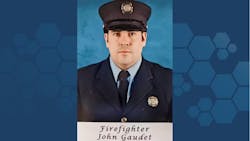Collapse Zone, Personnel Accountability Cited in Binghamton, NY, Firefighter LODD
Personnel accountability, strategy and tactical issues as well as dangers of vacant buildings were among factors that led to the death of Binghamton firefighter earlier this year, NIOSH investigators have determined.
Binghamton Firefighter John Gaudet, 40, was hit and killed by debris when walls collapsed at an arson fire on Feb. 12.
While responding, officers noted that there was a warning on dispatch software that the two structures had been deemed unsafe following a fire prevention bureau inspection. Firefighters were alerted not to enter.
An exterior attack was launched. When the walls collapsed, Gaudet and two other firefighters were struck by debris.
While the other firefighters were injured, Gaudet was heavily trapped under the concrete.
Following interviews with firefighters at the incident, investigators made the following recommendations:
• Establish and enforce collapse zones when a defensive strategy begins.
• Educate fire officers and firefighters in building performance under fire conditions and the potential for structural collapse.
• Establish divisions/groups with a supervisor or use multiple safety officers for fireground
management and risk assessment at geographically complex scenes, as early in the incident as possible.
• Ensure a rapid intervention team/crew is dedicated, assigned, and in place during structural
firefighting operations to immediately respond to a firefighter emergency.
• Use a personnel accountability system to identify the location and function of all operating personnel.
They also said local, state, and federal officials should ensure the delegated zoning or code enforcement authority, law enforcement agency, and fire department collaborate to proactively remediate vacant and abandoned buildings to reduce arson.
About the Author
Susan Nicol
News Editor
Susan Nicol is the news editor for Firehouse.com. She is a life member and active with the Brunswick Volunteer Ambulance & Rescue Company, Oxford Fire Company and Brunswick Vol. Fire Co. Susie has been an EMT in Maryland since 1976. Susie is vice-president of the Frederick County Fire/Rescue Museum. She is on the executive committee of Frederick County Volunteer Fire and Rescue Association. She also is part of the Maryland Institute for Emergency Medical Services Systems (MIEMSS) Region II EMS Council. Susie is a board member of the American Trauma Society, Maryland Division. Prior to joining the Firehouse team, she was a staff writer for The Frederick News-Post, covering fire, law enforcement, court and legislative issues.

